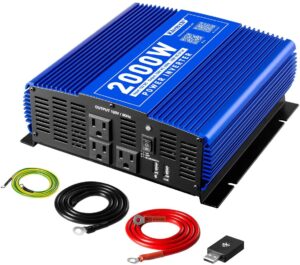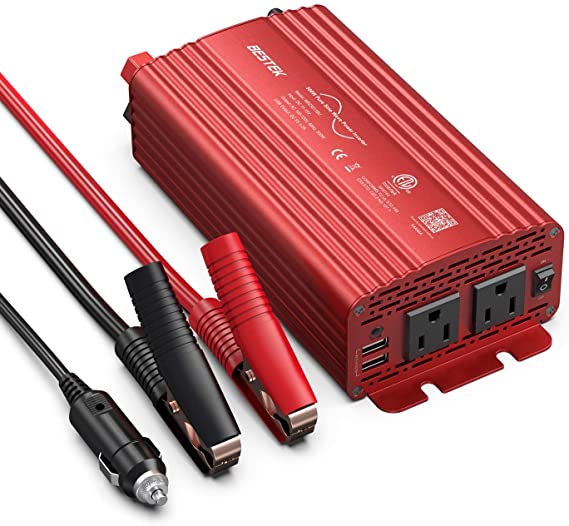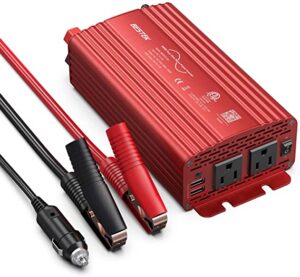On this page, you will see the best power inverters that sell on various online platforms. These power inverters are very popular so they drew my attention. However, I considered many factors for selecting these units. Some of the main factors are affordability, brand popularity, protection capability, advanced features, portability and versatility.
You will find power inverters that are suitable for vehicles, homes and DIY uses. The 12V power inverters can be connected with a 12V battery. After the successful inverter and battery connection, you will be able to charge your devices and power 110V home appliances. The best inverter review is based on those power inverters that come from popular brands such as BESTEK, POTEK, Energizer, Krieger, Maxpart, PowerDrive and others.
Best Inverters at a Glance
In the best inverter review, I have listed 10 power inverters as per my experience and research, please check:
| Image | Product | Our Rating | Warranty |
|---|---|---|---|
 |
BESTEK | 4.9 | 18 months |
 |
Maxpart | 4.3 | 12 months |
 |
Kinverch | 4.6 | Unavailable |
 |
BESTEK | 4.8 | Not available |
 |
KRIËGER | 4.5 | 3 years |
 |
Ampeak | 4.4 | 18 months |
 |
PowerDrive | 4.2 | Not available |
 |
Renogy | 4.3 | 1 year |
 |
Energizer | 4.5 | 2 years |
 |
POTEK | 4.7 | Not available |
The table contains top ten power inverters obeying the title of this page: Best Inverter Review.
BESTEK 300W Power Inverter – DC 12V to 110V AC Car Inverter

Bestek 300W – https://amzn.to/47cC9Us
When it comes to the best power inverters, Bestek is the winner. This is the reason of choosing BESTEK 300W power inverter. On this page, this is the power inverter that I kept on the first position of the inverter review.
BESTEK power inverters are used widely by majority of consumers. It reminds me of the best inverter manufacturer. In fact, the manufacturer also says that they are the number one leading inverter brand in America.
The 300W DC 12V to AC 110V converter is good for the fast charging performance. For powering various appliances, the power converter tool features two 110-volt AC sockets and two USB ports. Each USB port has 2.4A capability. Since you have two USB ports, you will be able to charge your USB-based devices in cars or homes.
Bestek 300 watts inverter carries a portable design so it can be the best companion of travelers, campers and those who need a portable power inverter. For a simplified use, it comes included with a cigarette lighter plug (two feet length). Most importantly, such lightweight and small power inverters are perfect for most cars such as Chevrolet, Ram, Toyota, Honda and any others.
Also, one cannot doubt its safety features because it carries a safe charging design that handles almost all inverter issues like over-voltage, over-heating, under-voltage, short-circuits and many others. Most importantly, high-class materials have been used to make this power inverter so it is strong enough from the outside. It greatly withstands any heavy bumps, strokes and other similar things.
PROS
- No overheating issues
- Delivers full rated power, i.e., 300W
- It can replace the need of using separate chargers in a vehicle.
- Inexpensive
- Perfect for most vehicles
- Less noise
- Simple cheap and good power inverter
- Great for charging phones and laptops
- Sells on Amazon, on-time product delivery from Amazon
- Customers are happy with the excellent customer service
- Compact and easy to store
- A great camping tool to inflate an air mattress
- A long lasting product. In some reviews, it was written that users have been using for more than 6 years without an issue.
CONS
- A user complained that it stopped working after 2.5 years of use.
- It does not support an iPhone charger. Bestek should add this feature
Maxpart 1000W Power Inverter
The main aim of the inverter review is to show you the best power inverters. So, I selected the Maxpart 1000W power inverter. It is perfect for vehicles such as RVs, trucks, cars and any others. The 12V DC to 110V AC power inverter has all the features and capabilities that will help deliver the best performance.

Maxpart 1000W – https://amzn.to/474pmUl
Just like the previous Bestek power inverter, the Maxpart also has dual AC sockets and dual USB ports. So, in total, you have four connection sockets to connect up to four devices. The USB ports have 2.4A capability that will surely deliver a fast charging performance.
From outside, the Maxpart power inverter looks solid and it comes included with all the connection components such as cigarette lighter plug, alligator clips, fuses and many others. Which means, you do not have to buy these accessories because they come included with the power inverter.
The two AC outlets and two USB ports are perfect for versatility and flexibility. Also, the 1000W output is huge to charge several appliances and USB devices at the same time.
Well, the inverter review tells that the Maxpart power inverter looks protective, capable, and high power and it comes included with a 2-year warranty. For the best protection, the vehicle inverter has a built-in fan that greatly prevents over-heating problems.
PROS
- Low noise is acceptable by many users.
- Affordable
- Portable and lightweight
- It uses the latest technology.
- Durable
- Great for camping and outdoor use
- It plugs very well, and it is easy to operate
- A quality product undoubtedly
- Very versatile as it have dual 110V outlets and dual USB ports
CONS
- Low quality clamps
- You may have to buy longer and heavy-duty cables because supplied cable is not very good.
- It is not a pure sine wave inverter.
- As per some complaints, it gets too hot, so please don’t place on a wood counter.
Kinverch 2000W Power Inverter
In the best inverter review, please know about this Kinverch 2000W power inverter. In fact, the power inverter is also available in other sizes such as 500W, 750W, 3000W and 5000W. If you buy products from Amazon, you will be able to buy it on Amazon.com as well.
Kinverch 2000W – https://amzn.to/3rJkdk5
From safety point of views, the Kinverch 2000-watt power inverter is very good because it has eight fuses configured inside. It has two cooling fans to provide sufficient temperature to the entire inverter system. With the help of eight fuses and two cooling fans, the power inverter protects itself and connected equipment from several electrical faults including short-circuits, voltage fluctuations, over inverter temperature and numerous other issues.
Such powerful power inverters are perfect for varieties of uses because it has three AC sockets and one USB port. Using these connection sockets, you will be able to connect both AC based devices and USB based devices. Of course, you will experience a fast charging outcome because Kinverch 2000W is a high-power inverter.
As mentioned above, it has two cooling fans that run conditionally. The fans are configured to run when the inverter temperature is more than 104° F. On certain level of load, the fan will start running also. So, the main job of these smart inverter fans is to maintain sufficient temperature in the inverter.
Also, I forgot to mention that the power inverter has Bluetooth capability. You will be able to control this power inverter using your cell phones and other Android devices. The wireless app based power inverter delivers modified sine wave power that is good for most of the devices. However, I admit that pure sine wave is better than modified sine wave. About its wireless capability, I want to say one thing that manufacturer says that it is the first wireless controllable power inverter in the modified sine wave inverter series of Kinverch.
PROS
- It is good for powering various home appliances such as refrigerators, fans, TVs etc.
- Reasonable price
- Noiseless
- Very well made
- External fuses
- Reasonable price
- Easy to use
- It has a power meter
- Fairly quiet
- A long lasting product
CONS
- An Amazon customer complained that he received a defective inverter.
- Approx 15% less capacity than advertised
- Low quality included accessories
- The app doesn’t work well
- It is a modified sine wave inverter, so it may not be good for the sensitive electronics.
BESTEK 500W Pure Sine Wave Power Inverter
At the first position of inverter review, you saw a 300W BESTEK inverter. Now please check 500W Bestek power inverter. This one is also very popular just like the previous one. The main capability of this BESTEK power inverter is the pure sine wave output, which is a demanded feature in power converters.

Bestek 500W – https://amzn.to/452jh8Y
Also, please know that Bestek 500W pure sine wave power inverter is an ETL listed product that means it is highly secure to use anywhere you want. It is perfect for vehicles but you can also use it to power home appliances because it offers huge 500 watts output.
Using this BESTEK power inverter, you will be able to power several devices that run on pure sine wave power. As a result, you will be able to run printers, electric drills, cameras, car dash cams, CPAP machines, hair straightener, hair dryers, induction cookers, laptops, microwave ovens and refrigerators.
The Bestek 500-watt power inverter has many capabilities that you may not find in most power inverters. The pure sine wave power inverter is perfect for an off-grid system because it has low THD. An inverter having low THD means lower peak power, less temperature. It is also helpful to optimize electromagnetic emissions.
To make sure you get a sturdy power inverter, the BESTEK power inverter’s outer shell is made of long-lasting aluminum material that can surely withstand bumps, drops and any types of strokes.
PROS
- True sine wave power is confirmed by many users.
- Variable fan speeds.
- Fan noise is acceptable as mentioned by many users at Amazon.
- Solid feel from outside
- It works well.
- Perfect for inflating a mattress, charging laptops and more
- It works as advertised.
- It is a handy inverter with a cigarette lighter plug.
- Consumes less power than a modified sine wave inverter
- Good customer service
CONS
- The USB ports work very well but they are misaligned as mentioned by some customers.
- Some users complained that it got warm at half load.
- The fan runs continuously, even without the load.
- Cables are a little short.
- The cooling fan is a bit noisy.
KRIËGER 1100 Watt 12V Power Inverter
In the best inverter review, now please check KRIEGER 1100W power inverter. The 12V to 110V power inverter is stylish, portable and a lightweight unit. To give you varieties, the Krieger 1100 watts power inverter is made in different wattage such as 1100W, 1500W, 2000W, 3000W and 4000W.
Krieger 1100W – https://amzn.to/3OgpqHK
Well, there are several good reasons of including this power inverter in the best inverter reviews. First, it is a MET approved product. Second, it comes in various sizes. Third, it is solid, portable and stylish.
The one major downside I see is the modified sine wave capability. Other than this, most of the features and capabilities look fine to me. The 1100W power inverter has 2200W peak power and it is a great tool to convert 12V DC power to 110V/120V AC power. For more than 150W power requirement, you need to connect it with the battery directly using the alligator clips. One more thing in this power inverter is the remote control capability. Yes, it has a wired remote control that gives you the freedom to control the inverter remotely.
Also, according to the manufacturer, the Krieger 1100W power inverter is well protected so you do not have to worry of any power faults. It also features an LCD that shows live information on power uses and other electrical status.
Moreover, the well tested and METLab approved power inverter is backed by 3 years warranty. Which is the major plus point in this power inverter. Actually, the manufacturer is very confident to their product so they offer a long time warranty on this Krieger 1100W power inverter.
PROS
- METLab approval
- 3 years warranty is huge.
- Affordable price
- It works as expected.
- Compact size
- The display shows battery voltage and watts in use.
- A well-built inverter
- Easy to setup
- Good packaging with required accessories
- A long lasting product. For a user, it has been working for 5 years.
CONS
- Modified sine wave
- The product description is a big inaccurate.
- Short power cable but it works for the purpose.
Ampeak 2000W Power Inverter
Ampeak 2000 watt power inverter is also a reputed member of the best inverter reviews. Like previous inverters on this page, the Ampeak power inverter also comes with many positives and a few negatives.

Ampeak 2000W – https://amzn.to/43N78DT
Those who are familiar with the Ampeak inverter brand and explore some of their power inverters then they can find this Ampeak power converter in 1000W and 2000W size. Depending on your requirement, you can choose the inverter, either the 1000watt or the 2000watt power inverter. The 2000W Ampeak inverter has one more variation that comes with a remote control capability.
The high capacity Ampeak 2000W power converter is a good tool to convert DC 12V to AC 110V. It has 4000-watt peak power and features various connection sockets that you can use to connect your appliances. The 12V power converter features three 110V AC outlets and one USB port. You can use the three AC sockets for powering your home appliance. Of course, you can use these AC 110V sockets in your vehicle to power those appliances that consume power at a large amount. In fact, the possibility is endless because you will be able to power any equipment or personal devices. Please make sure the devices will not get more than the total output, which is the 2000W output power.
In Ampeak power inverter, protection features are available. The 110V power inverter has 10 mini fuses of 35A each. The inverter has two cooling fans, a digital display and an alarm. As a result, the best protection Ampeak power inverter will get rid of all the common electrical faults such as short circuits, over-voltage, under-voltage, over-temperature and many others.
More importantly, the solid power inverter comes high quality cables joined with insulated rings. Actually, the manufacturer claims that these ring terminal cables are more reliable than the alligator clips and cables. Most power inverters have aluminum shell but this inverter has ABS shell that is good for protection against outer touches, bumps and other similar things.
To use the Ampeak inverter, you will need a 12-volt battery. After battery and inverter connection, you will be able to power your desired appliances. Please know that the inverter will stop working if you give it more than 2000W load. Also, the ETL certified power inverter is protected by an 18-month warranty and 24-hour customer service.
PROS
- ETL approved
- 18-month warranty
- Reliable battery cables/li>
- Solidly made
- Lightweight unit because it is made of plastic material
- Good for various kitchen appliances and industrial tools
- Easy to install with the help of high quality supplied cables
- The average size inverter is easy to store.
- Price and performance are amazing.
- Configurable to a solar panel
- Overall, great product, very robust & made of excellent materials
- Good price
CONS
- Fan is a little lauder than expected
- The display doesn’t show accurate material.
- Some accessories such as nuts & bolts are not provided.
PowerDrive PD3000 3000 Watt Power Inverter
If you are looking to buy a slim and portable power inverter then PowerDrive PD3000 can be the best power inverter for you. It offers 3000 watts output and it is a wireless capable inverter. So, for a remote access, you can use your Android phone to control this power inverter.

PowerDrive PD3000 – https://amzn.to/3Qe3EXV
PowerDrive PD3000 is a part of inverter review because it has a unique design, 3000-watt output capacity and various features that make it a special power inverter. The good-looking power converter features four AC outlets (three-prong). To connect USB devices, you can use its USB ports because it features two USB ports.
The control panel of PowerDrive PD3000 is detachable. If you want to access it remotely, you can detach the control panel that allows you to monitor the inverter remotely. In case, you want to control this power inverter using your Android phone, please download the free App that will help you access the settings and features of this power inverter.
Please know that one of the USB ports is USB-C 3.0A port that is an advanced connection port that has uses more than a USB port. The USB-C connection is used to charge small devices such as laptops, smartphones, cameras and many others.
PROS
- It is good for running DIY tools: small compressors, shop saws and many others.
- PowerDrive is a reputed brand that has passed more than 20 years in manufacturing powerful inverters.
- The 3000W power inverter is perfect for trucks, semi-trucks, RVs and many others.
- It is easy to monitor remotely because of the wireless capability and the detachable control panel.
- Great product and good quality
- From Amazon, it is shipped timely and came with all the required accessories.
- Good for powering kitchen appliances and power tools
- Good price
CONS
- Some customers complained that it did not last longer.
- As per a customer, the app is useless.
- For a user, it didn’t last for a long time.
- Many customers complained that it worked for few weeks and died.
Renogy 3000W Pure Sine Wave Inverter
Renogy 3000W pure sine wave inverter is a highly rated product on Amazon. That is the reason to include it in the best inverter review. The Renogy 12V power inverter is available in four sizes such as 700W, 1000W, 2000W and 3000W.
Renogy 3000W – https://amzn.to/44LzDTI
From the Renogy power inverters, you can expect clean output because they are pure sine wave inverters. The inverter has low THD that means high quality, high level of safety and seamless power output. The output you get from this Renogy 3000W power inverter is perfect for almost all devices including the sensitive electronics. More importantly, the 110V power inverter has more than 90% efficiency.
To protect the connected appliances and the power inverter itself, it is based on an advanced protection mechanism. It has fault alarm, LED indicators that alert you when the things go wrong. As a result, you can expect protection from common electrical faults including over-current, under-current, over-heat, short circuits and GFCI.
For an easy monitoring, the Renogy 3000W power inverter is remote controllable. To use its remote functionality, you need to install the remote control that comes included with all the components for the installation. Additionally, Renogy 3000W power inverter is an ETL approved product so you will not have any fears related to safety of the product.
The Renogy power inverter has an On/Off switch that is for controlling AC output so when you need the AC output, you can switch it on and vice versa. You also get several AC outlets, each AC outlet has 115V, 60Hz and up to 15A capability. The USB port has 5V/2.1A charging capability, which is good for charging USB devices. You will be able to power your smartphones, tablets and other USB-enabled devices.
PROS
- Easy to install
- Pure sine wave output
- GFCI protection
- Perfect for most kitchen appliances
- Good price
- It arrives well packaged with a complete set of instructions.
- Efficient
- Runs quietly
- Easy to install
- Reliable
CONS
- Customer service is not reliable
- Some customer complained because the cables are not included.
- It doesn’t deliver the full rated power.
- A user didn’t receive the battery cables.
Energizer 1100 watts power inverter, modified sine wave car inverter, 12V DC to 110V AC
Energizer is one of the top inverter brands. That is why; I included the Energizer 1100W power inverter in the best inverter review. The modified sine wave power converter comes with all the features and capabilities that you need for the good inverter performance. Most importantly, it is a UL certified product so you should not have any doubts to its quality, safety capabilities and the performance.

Energizer 1100W – https://amzn.to/3Ki7yeu
The 12V DC to 110V AC Energizer power converter has two AC outlets and two USB ports. It delivers 1100W continuous and 2200W peak power. What is peak power? Peak power is used as start-up power to start some large appliances that require more than normal power at the start-up. Please know that the peak power lasts for few seconds only.
In case, you need to buy a power inverter for emergencies, power shortage, storms, hurricane, you must buy this powerful inverter. The inverter’s outlets are compatible with the North American household requirements. Each AC outlet has 15A capability and it delivers 110V Ac power that you can use to power your appliances.
Since the power converter comes from the trusted brand, i.e., Energizer so you will not get any difficulties for using it. You will also not have any protection related issues because it is a highly protected power inverter. Undoubtedly, you can expect protection from over-current, over-temperature, short circuits and other related problems. Please note that before anything you power, you need to establish a connection between the inverter and a battery. After that, you will be able to power your desired appliances. Additionally, you get a 2-year of warranty on this product so you do not have to worry of anything.
PROS
- Many customers have appreciated the two-year warranty that comes attached with the inverter.
- The power inverter comes included with cables and other needed items.
- Many people have connected it with a 1000W solar panel and the inverter gave good performance to them.
- The inverter is well made.
- Decent packaging
- The display shows both volts and watts.
- Reliable
- Simple installations and controls
CONS
- Some customer complained that it failed to deliver the rated power.
- Short cables
POTEK 750W Power Inverter DC 12V to AC 115V Car Converter with 2A USB Charging Port
Potek is also one of the popular power inverter brands. So, I have included the Potek 750W power inverter in the best inverter review. On this page, I have assigned the last position to this power inverter but it is a powerful unit. Only on Amazon, approx. 1500 units have been sold and it has received good ratings from the existing users.
Potek 750W – https://amzn.to/454LvzN
The 12V Potek power inverter is currently available in two sizes such as 500W and 750W. You can choose a size based on your power consumption needs. Well, this inverter review is about the 750W model that has 1500W peak power. I have already explained what the peak power is.
To convert 12V DC power to 110V AC power, you can buy this power inverter because it is a highly rated product. I can say that it is highly sold product on Amazon. The Potek power converter comes included with battery clamps and the cigarette lighter adapter.
Today, most power inverters come with both AC outlets and USB ports; this one also has dual AC outlets and one USB ports. Please use the USB port for charging mobile phones and other USB gadgets while the AC 110V outlets are for large appliances that run on 110V input power.
For a lightweight use, the power inverter is built compactly. It has a compact design that will surely meet the need of the portable uses. Such lightweight power inverters are ideal for travelers, vacations, work trips, camping tours, business trips and other outdoor activities.
To protect you, your devices and the unit itself, the POTEK power inverter has two fuses that get rid of all the power faults. As a result, it is capable to withstand faults coming from the inverter circuits, wires, outlets or somewhere else. Each fuse has 40A capability that is good to protect short circuits, over-current and other similar stuffs. The highly protective power inverter comes included with two battery cables, four spare fuses, one user manual and customer service.
PROS
- Customers do not have problems dealing with Potek customer care executives: very responsive.
- Silent operation
- Delivers reliable performances, people are able to get the full rated power.
- POTEK is a trusted and reputed brand.
- A long lasting and solid inverter
- Compact size
- Very handy for a car
CONS
- Some customers found miss-information in the provided manual. Please read inverter review to find the truth.
- It is a modified sine wave inverter, so it may not be a good inverter for sensitive electronics.
How to Determine Inverter Size for a Solar Panel
In case, you need to buy a solar inverter for your solar panel then the best guide you will get from the suppliers. However, as a rule of thumb, the inverter wattage should be equivalent to the solar wattage. Which means a 1000W solar panel needs a 1000W inverter, minus/plus few watts.
However, it will be the best practice if you talk directly with your supplier because there are some technical terms involved that determine the size.
To determine the size of an inverter, three factors are considered. These factors are solar array, geography and site-specific situations.
Here, solar array is a crucial factor because it is responsive to produce the DC current. The DC power comes from the solar array. The inverter should have the capacity to handle the DC power produced by the solar array.
After the solar array, geography is also very important factor for producing DC current. Please know that DC current produced in one geography may not be equal to DC current produced in other geography. Apart from the solar array and the geography, site-specific factors are also considered because it is also responsible to producing DC current. The DC current, you get from your solar panel is dependent on how well the solar panel is installed. The directional factors such as tilt and azimuth are responsible to draw DC current from the solar array so it should be properly configured.
Watts
Watts refer to the power measurement that an appliance supplies or draws. In case, an appliance draws 480-watt that can be calculated using V x A formula (voltage multiplied by Amps). For an example, an appliance draws 40 amps at 12V then 40A x 12V = 480W. Or, an appliance draws 20A at 24V then 20A * 24V = 480W.
Pure Sine Wave vs Modified Sine Wave
I will explain some of the main advantages of pure sine wave over modified sine wave that will be good to know the actual difference between pure sine wave and modified sine wave.
In fact, pure sine wave output has very low harmonic distortion. It is a clean electricity same as the utility supplied power. With pure sine wave, inductive load appliances run very well; they run silently at a good speed. Also, you will not have any noise related issues because it is a clean power that greatly reduces noise coming from appliances such as fans, amplifiers, TVs and printers.
Impressively, pure sine wave power is very helpful to prevent crashes, minimize noises and faults from the connected appliances. In fact, pure sine wave is considered reliable power that is fine with sensitive electronics.
Many sensitive appliances will not work on modified sine wave powers. If they will work then you get numerous operational problems. Therefore, on modified sine wave power, you should not run appliances such as laser printers, certain laptops, fluorescent lights, variable speed DIY tools, cordless tools, furnaces, radios, sewing machines, digital clocks and various medical equipment.
Installing a Power Inverter and the Appropriate Cable Size
Most car inverters that have less than 500W power comes with a cigarette lighter plug. Via the cigarette lighter plug, you will not be able to draw more than 150W power. These power inverters also come with cables that can be used to connect with the battery directly. Hence, it is advised that if you need to use the cigarette lighter plug, please choose the power inverter that has less than 500W total output.
Power inverter with more than 500W output must be connected with the battery directly using alligator clips and cables. The cable sizes are based on the distance between inverter and battery. For specific information, please refer to the owner manual.
At the time of connecting your power inverter with the battery directly, please consider using safety fuses because these fuses prevent over-current and short circuits. Also, it is recommended to use a thicker wire if possible. For the optimal workings, the distance between inverter and battery should not be too long. The maximum recommended distance is up to ten feet but shorter is better.
Conclusion – Best Inverter Reviews
In short, the best inverter review contains 10 powerful inverters. These power inverters convert 12V DC to 110V AC power. You can use these power inverters in your vehicles such as cars, trucks, semi-trucks, RVs, boats and others.
On this page, you will be able to see power inverters in different sizes ranging from 300W to 3000W. At the time of writing this review, these power inverters are available on Amazon so if you want to buy one, please check with Amazon.com.
Some of the low-wattage power inverters on this page come with a cigarette lighter plug that you can use in your cars to charge your laptops, smartphones and other USB-enabled devises. You will also be able to find some high-wattage power inverters that can be used to run large appliances such as fridges, TVs, microwaves and others. Additionally, the best inverter reviews have both pure sine wave and modified sine wave power inverters. Please choose a sine wave depending on your needs. Some of the power inverters come with a remote control too. So, in case you want to access the power inverter remotely, choose those inverters that have a remote control.
